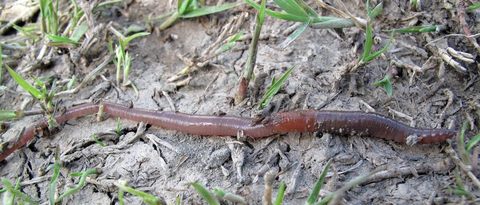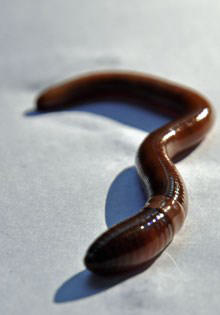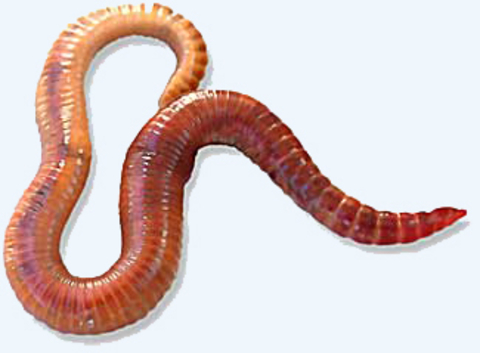Quick facts
Earthworm is an invasive species.
- Many earthworms eat the duff layer on the ground in the hardwood forest, reducing the available composting material on the forest floor.
- Don't dump worms in the woods.
- Dispose of unwanted bait in the trash.
Earthworms are not regulated in Minnesota. They are monitored on Great Lakes Worm Watch.
How to identify earthworms
- There are thousands of species of earthworms across the world. The species found across the Great Lakes region originated from Europe and Asia.
- There are no native earthworms in Minnesota.
- Adult earthworms are easier to identify than immature earthworms. Adults have a collar-like structure (called a “clitellum”) near the front of their bodies.
- Earthworms are divided into three main groups by where they live within the soil: leaf litter dwellers, soil dwellers and deep burrowers.
- Leaf litter dwellers are reddish-brown, small and usually less than 3 inches long when mature.
- Soil dwellers live in the top 20 inches of soil.
- They are light gray and sometimes have a pink head and range in size from 1 to 5 inches.
- Deep burrowers dwell 6 feet deep but feed on fresh surface litter.
Life cycle
- Many earthworms are hermaphroditic but must have two worms cross-fertilize for reproduction.
- Some species can reproduce on their own from an unfertilized egg.
Angle worms
Aporrectodea, Octolasion spp.
- Angle worms eat the duff layer on the ground in the hardwood forest, reducing the available composting material on the forest floor.
- This change can limit native tree regeneration, improving soil habitat for some non-native species like buckthorn.
How to identify angle worms
- Soil dwelling, living in the top 15 to 20 inches of soil.
- Pink-peach toned with a well-defined raised band (clitellum) lower on the body than jumping worms.
Life cycle
- Lifespan varies from annual to a few years, depending on the depth of ground freeze during winter.
- Adults are killed by freezing.
- Eggs in cocoons deposited in the soil during summer and fall will survive and hatch in the spring.
Jumping worms
Amynthas spp.
- Jumping worms live in the leaf litter and the top few inches of soil on the forest floor.
- They do not burrow like other worms.
- They change the soil texture to appear like coffee grounds, strip the soil of nutrients and can kill plants.
How to identify jumping worms
- Jumping worms are surface and shallow-soil dwellers.
- They can be 1-1/2 to 8 inches or more in length.
- They are similar in size to nightcrawlers or some of the larger angle worms, but their clitellum (collar-like structure) and coloring are different.
- The clitellum is located 1/3 down the length of the worm from the head and it is smooth, cloudy-white and constricted.
- As their name suggests, these worms may jump noticeably when disturbed.
Life cycle
Most jumping worms in Minnesota are likely annual.
See plant sale recommendations for reducing jumping worm spread.
Nightcrawler
Lumbricus terrestris
- Nightcrawlers create and maintain a duff-free, mid-summer condition indefinitely in hardwood forests by eating the leaf litter from the previous season.
- This prevents a new duff layer from establishing.
How to identify nightcrawlers
- Nightcrawlers are deep burrowers but surface to forage for food.
- Adults can range from 5 to 8 inches long.
- Nightcrawlers have a swollen, collar-like structure (clitellum) that is saddle-shaped and does not go all the way around the worm’s body.
Life cycle
- Nightcrawlers have a slower life cycle and a longer lifespan than other worm species found in Minnesota.
- They generally hibernate below the frost line and lay relatively small numbers of cocoons.
Red wiggler
Eisenia fetida
- Red wigglers are used in composting.
- Although not currently thought to survive Minnesota winters, they could become a threat to native forests if they are found to survive and escape to native landscapes.
How to identify red wigglers
- Surface dwelling.
- 1 to 5 inches long with a strong red-brown colored backside.
- Fresh specimens have yellow bands in the grooves between segments.
- This species produces a pungent liquid when roughly handled.
Life cycle
- Worms hatch from cocoons and mature in about 30 days.
- Each worm has male and female organs, but they mate with each other.
- They can produce two cocoons per week and lay them near the soil surface.
Reviewed in 2023






